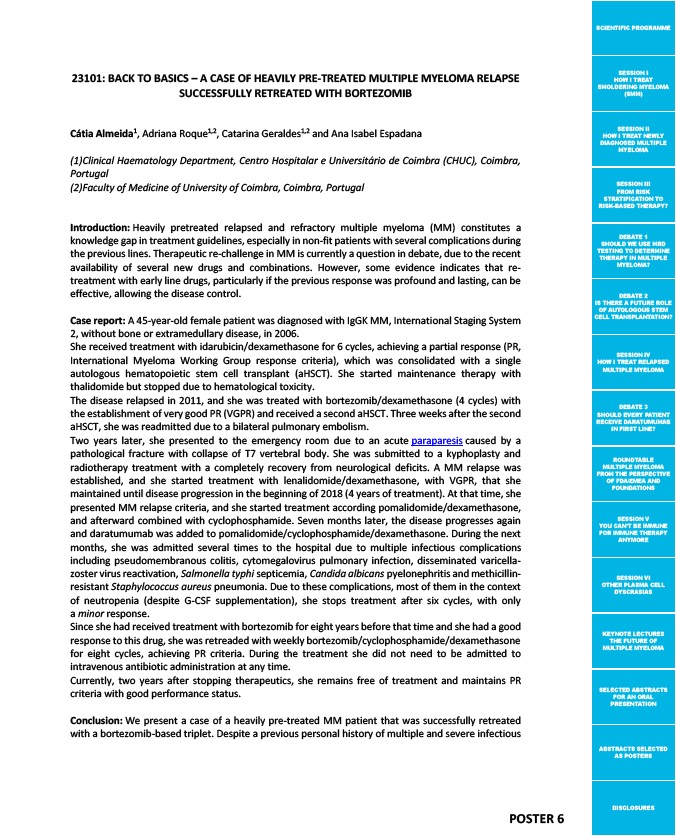
SCIENTIFIC PROGRAMME
SESSION I
HOW I TREAT
SMOLDERING MYELOMA
(SMM)
SESSION II
HOW I TREAT NEWLY
DIAGNOSED MULTIPLE
MYELOMA
SESSION III
FROM RISK
STRATIFICATION TO
RISK-BASED THERAPY?
DEBATE 1
SHOULD WE USE MRD
TESTING TO DETERMINE
THERAPY IN MULTIPLE
MYELOMA?
DEBATE 2
IS THERE A FUTURE ROLE
OF AUTOLOGOUS STEM
CELL TRANSPLANTATION?
SESSION IV
HOW I TREAT RELAPSED
MULTIPLE MYELOMA
DEBATE 3
SHOULD EVERY PATIENT
RECEIVE DARATUMUMAB
IN FIRST LINE?
ROUNDTABLE
MULTIPLE MYELOMA
FROM THE PERSPECTIVE
OF FDA/EMEA AND
FOUNDATIONS
SESSION V
YOU CAN’T BE IMMUNE
FOR IMMUNE THERAPY
ANYMORE
SESSION VI
OTHER PLASMA CELL
DYSCRASIAS
KEYNOTE LECTURES
THE FUTURE OF
MULTIPLE MYELOMA
SELECTED ABSTRACTS
FOR AN ORAL
PRESENTATION
ABSTRACTS SELECTED
AS POSTERS
DISCLOSURES
23101: BACK TO BASICS – A CASE OF HEAVILY PRE-TREATED MULTIPLE MYELOMA RELAPSE
POSTER 6
SUCCESSFULLY RETREATED WITH BORTEZOMIB
Cátia Almeida1, Adriana Roque1,2, Catarina Geraldes1,2 and Ana Isabel Espadana
(1)Clinical Haematology Department, Centro Hospitalar e Universitário de Coimbra (CHUC), Coimbra,
Portugal
(2)Faculty of Medicine of University of Coimbra, Coimbra, Portugal
Introduction: Heavily pretreated relapsed and refractory multiple myeloma (MM) constitutes a
knowledge gap in treatment guidelines, especially in non-fit patients with several complications during
the previous lines. Therapeutic re-challenge in MM is currently a question in debate, due to the recent
availability of several new drugs and combinations. However, some evidence indicates that re-treatment
with early line drugs, particularly if the previous response was profound and lasting, can be
effective, allowing the disease control.
Case report: A 45-year-old female patient was diagnosed with IgGK MM, International Staging System
2, without bone or extramedullary disease, in 2006.
She received treatment with idarubicin/dexamethasone for 6 cycles, achieving a partial response (PR,
International Myeloma Working Group response criteria), which was consolidated with a single
autologous hematopoietic stem cell transplant (aHSCT). She started maintenance therapy with
thalidomide but stopped due to hematological toxicity.
The disease relapsed in 2011, and she was treated with bortezomib/dexamethasone (4 cycles) with
the establishment of very good PR (VGPR) and received a second aHSCT. Three weeks after the second
aHSCT, she was readmitted due to a bilateral pulmonary embolism.
Two years later, she presented to the emergency room due to an acute paraparesis caused by a
pathological fracture with collapse of T7 vertebral body. She was submitted to a kyphoplasty and
radiotherapy treatment with a completely recovery from neurological deficits. A MM relapse was
established, and she started treatment with lenalidomide/dexamethasone, with VGPR, that she
maintained until disease progression in the beginning of 2018 (4 years of treatment). At that time, she
presented MM relapse criteria, and she started treatment according pomalidomide/dexamethasone,
and afterward combined with cyclophosphamide. Seven months later, the disease progresses again
and daratumumab was added to pomalidomide/cyclophosphamide/dexamethasone. During the next
months, she was admitted several times to the hospital due to multiple infectious complications
including pseudomembranous colitis, cytomegalovirus pulmonary infection, disseminated varicella-zoster
virus reactivation, Salmonella typhi septicemia, Candida albicans pyelonephritis and methicillin-resistant
Staphylococcus aureus pneumonia. Due to these complications, most of them in the context
of neutropenia (despite G-CSF supplementation), she stops treatment after six cycles, with only
a minor response.
Since she had received treatment with bortezomib for eight years before that time and she had a good
response to this drug, she was retreaded with weekly bortezomib/cyclophosphamide/dexamethasone
for eight cycles, achieving PR criteria. During the treatment she did not need to be admitted to
intravenous antibiotic administration at any time.
Currently, two years after stopping therapeutics, she remains free of treatment and maintains PR
criteria with good performance status.
Conclusion: We present a case of a heavily pre-treated MM patient that was successfully retreated
with a bortezomib-based triplet. Despite a previous personal history of multiple and severe infectious